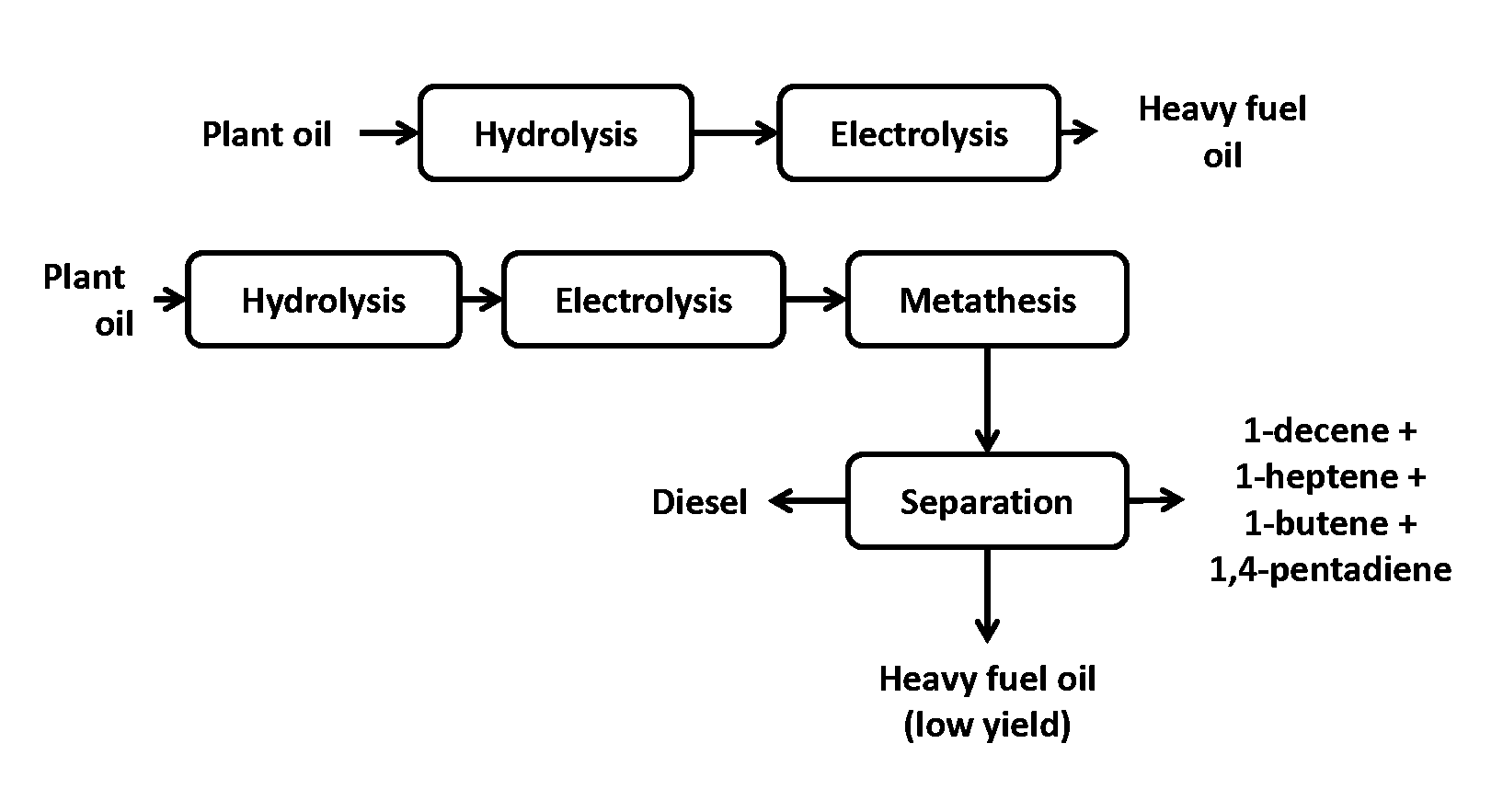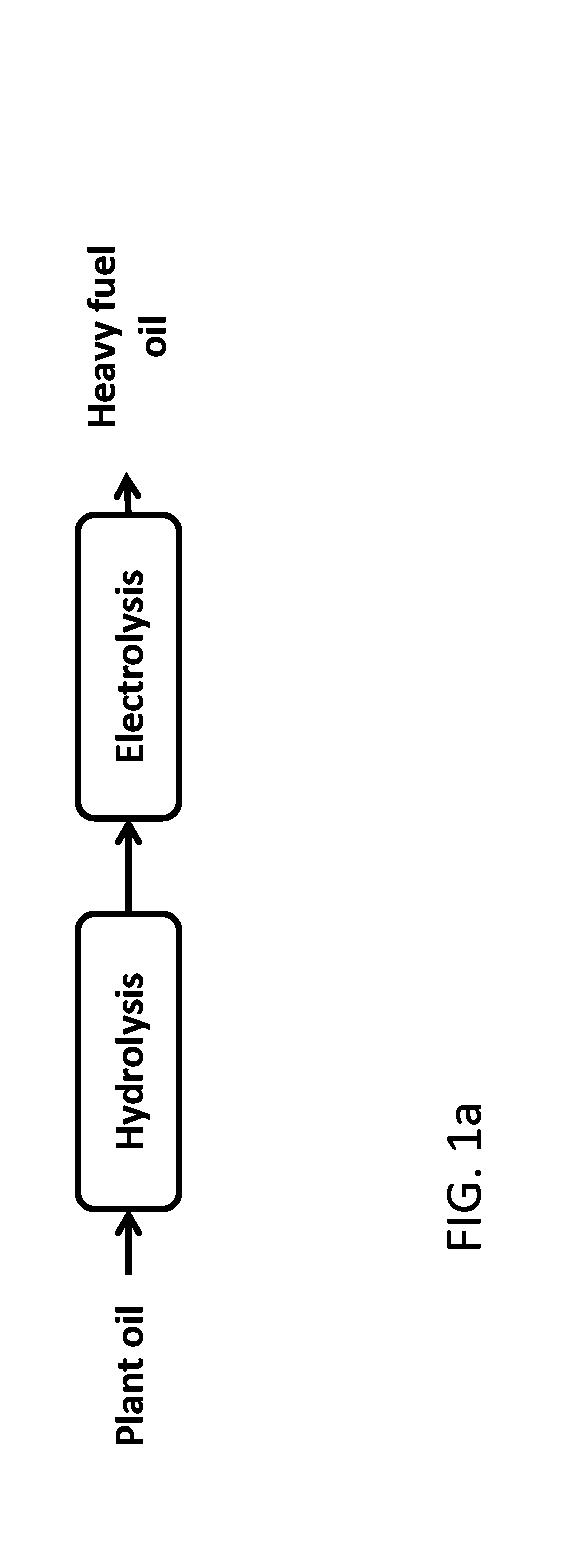High productivity Kolbe reaction process for transformation of fatty acids derived from plant oil and animal fat
a fatty acid, high-productivity technology, applied in the direction of electrolysis organic production, hydrocarbon preparation catalysts, hydrocarbon oil treatment products, etc., can solve the problems of low economic benefits of microbial-produced hydrocarbons, low etc., to reduce the passivation voltage of electrodes, increase the productivity of kolbe electrolysis reaction, and improve the effect of electrolysis efficiency
- Summary
- Abstract
- Description
- Claims
- Application Information
AI Technical Summary
Benefits of technology
Problems solved by technology
Method used
Image
Examples
example 1
Kolbe Electrolysis Reaction of Beef Tallow-Derived Fatty Acids
[0075]9.44 parts fatty acids derived from the hydrolysis of beef tallow was added to 89.69 parts methanol; 0.87 parts potassium hydroxide was added to the mixture, which was then heated to 52° C. in a water-jacketed vessel, obtaining a clear solution. An electrolysis cell, consisting of platinum foil anode and nickel cathode separated by 1.5 mm gap, was immersed into the solution. A constant electrical current density of 0.2 A cm-2 was applied. Within 1 hour, hydrocarbon product separated from the reaction mixture and accumulated at the bottom of the reactor, comprising coupled Kolbe electrolysis products and disproportionation products.
example 2
Kolbe Electrolysis Reaction of Oleic Fatty Acid in Presence of 0.6 Wt. % Acetic Acid of Total Acids
[0076]16.49 parts oleic acid, 0.10 parts acetic acid (0.6 wt. % of total acid), and 0.98 parts sodium hydroxide was dissolved in 59.47 parts ethanol and 22.96 parts water, which was then heated to 50° C. in a water jacketed vessel. An electrolysis cell, consisting of platinum foil anode and platinum foil cathode separated by 1.5 mm gap, was immersed into the solution. A constant electrical current density of 0.2 A cm-2 was applied. After 50 minutes of electrolysis an aliquot of the reaction mixture was acidified and extracted into hexane, which was then analyzed by gas chromatography to calculate current yield and productivity (see Table 2).
example 3
Kolbe Electrolysis Reaction of Oleic Fatty Acid at a Moderate Electrical Current Density
[0077]16.26 parts oleic acid and 1.15 parts sodium hydroxide was dissolved in 53.52 parts ethanol and 29.07 parts water, which was then heated to 50° C. in a water-jacketed vessel. An electrolysis cell, consisting of platinum foil anode and platinum foil cathode separated by 1.5 mm gap, was immersed into the solution. A constant electrical current density of 0.1 A cm-2 was applied. After 100 minutes of electrolysis an aliquot of the reaction mixture was acidified and extracted into hexane, which was then analyzed by gas chromatography to calculate current yield and productivity (see Table 2).
PUM
| Property | Measurement | Unit |
|---|---|---|
| weight percent | aaaaa | aaaaa |
| weight percent | aaaaa | aaaaa |
| temperature | aaaaa | aaaaa |
Abstract
Description
Claims
Application Information
 Login to View More
Login to View More - R&D
- Intellectual Property
- Life Sciences
- Materials
- Tech Scout
- Unparalleled Data Quality
- Higher Quality Content
- 60% Fewer Hallucinations
Browse by: Latest US Patents, China's latest patents, Technical Efficacy Thesaurus, Application Domain, Technology Topic, Popular Technical Reports.
© 2025 PatSnap. All rights reserved.Legal|Privacy policy|Modern Slavery Act Transparency Statement|Sitemap|About US| Contact US: help@patsnap.com



